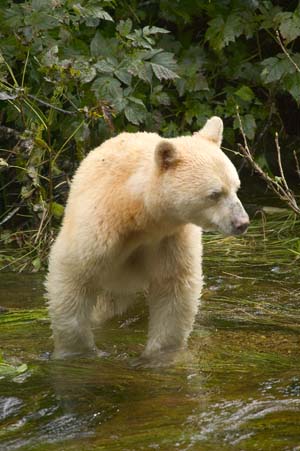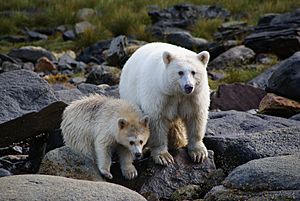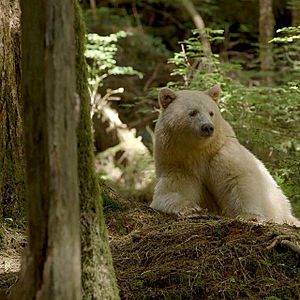Spirit bear facts for kids
Quick facts for kids Kermode bear |
|
|---|---|
 |
|
| Conservation status | |
| Scientific classification |
|
| Kingdom: | Animalia |
| Phylum: | Chordata |
| Class: | Mammalia |
| Order: | Carnivora |
| Family: | Ursidae |
| Genus: | Ursus |
| Species: | |
| Subspecies: |
U. a. kermodei
|
| Trinomial name | |
| Ursus americanus kermodei Hornaday, 1905
|
|
The spirit bear, also known as the Kermode bear (Ursus americanus kermodei), is a special kind of American black bear. It lives in the beautiful forests along the coast of British Columbia, Canada. This bear is so important that it's the official mammal of British Columbia and a symbol for the town of Terrace, British Columbia.
Most Kermode bears are black, just like other American black bears. But between 100 and 500 of them are completely white! These white bears are the ones called spirit bears. You can find most of them on three islands in British Columbia: Gribbell, Princess Royal, and Roderick. On these islands, white bears make up 10% to 20% of the Kermode bear population.
Spirit bears are very important in the stories and traditions of the Native peoples who live in the area. These amazing bears have even been shown in a National Geographic documentary and the BBC TV series Planet Earth III.
Contents
Meet the Kermode Bear

The Kermode bear was named after Frank Kermode. He was a director at the Royal B.C. Museum and studied this special bear. He worked with William Hornaday, the scientist who first described the bear.
White Kermode bears are not albinos. Albinos have no color at all, but spirit bears still have some color in their skin and eyes. Their white fur is caused by a special gene. This gene stops their bodies from making the usual dark color. If a bear gets two copies of this special gene, one from each parent, it will have white fur. If it has only one copy, or no copies, it will be black.
Sometimes, two black bears can have a white cub! This happens if both black parents carry one copy of the special white-fur gene. If the cub gets that gene from both parents, it will be white. Scientists have also found that white Kermode bears often choose to mate with other white bears. Black Kermode bears tend to mate with other black bears. This might be because young bears learn what their mother's fur color looks like and prefer that color when they grow up.
What Do Spirit Bears Eat?
Kermode bears eat many different things throughout the year. For most of the year, they eat plants and berries. But in the fall, when salmon swim upstream to lay their eggs, these bears become expert fish hunters.
White spirit bears are actually better at catching salmon than black bears. Studies show that white bears catch 35% more salmon during the day. This is because salmon find it harder to see a large white bear in the water compared to a large black bear. The white fur helps the bear blend in with the sky when seen from underwater. Because of this, white Kermode bears often have more nutrients from fish in their fur, showing they eat more salmon than the black bears.
Where Do Spirit Bears Live?

The Kermode bear lives along the coast of British Columbia, from Princess Royal Island up to Prince Rupert, British Columbia, and inland towards Hazelton, British Columbia. In the Tsimshianic languages, the bear is called moksgmʼol.
In 2006, the government of British Columbia officially named the Kermode bear as the province's animal. A male Kermode bear can weigh 225 kilograms (about 500 pounds) or more. Females are smaller, weighing up to 135 kilograms (about 300 pounds). When standing up tall, a Kermode bear can be 180 centimeters (about 6 feet) high.
Scientists believe there are fewer than 400 white-colored bears in the coastal area. This area stretches from Southeast Alaska down to the northern tip of Vancouver Island. About 120 of these white bears live on the large Princess and Prince Royal Islands. The biggest group of white bears lives on an 80-square-mile area of Gribbell Island, which is part of the Gitgaʼata people's territory.
The homes of these bears were once threatened by a proposed oil pipeline called the Enbridge Northern Gateway Pipelines. This pipeline was planned to go near the Great Bear Rainforest. Many Indigenous groups, including the Gitgaʼat, were against the pipeline. Luckily, the Canadian government rejected the pipeline in 2016.
Protecting Spirit Bears
Even though Kermode bears are not considered rare, many people are working hard to protect them. This is because the bear is very important to the culture of the area.
Salmon are a very important part of the Kermode bears' diet, especially in the fall. Salmon are also a "keystone species." This means they are vital to the health of both the water and the land around them. When salmon swim upstream to spawn, they bring nutrients to the rivers. When bears and other animals eat salmon and leave parts of them in the forest, these nutrients help the land too.
In 2012, the First Nations groups living along the coast banned trophy hunting of all bears in their lands within the Great Bear Rainforest. Then, in 2017, after many people asked for it, the government of British Columbia also banned grizzly bear trophy hunting in the Great Bear Rainforest. However, hunting black bears is still allowed. One concern is that some people might hunt bears illegally, which is called poaching.
Grizzly bears can also be a threat to Kermode bears. This is because natural resources, especially salmon, are becoming harder to find due to climate change and too much fishing. Scientists have used hair traps to track grizzlies. They found that grizzlies are moving into areas where black bears and Kermode bears usually feed on salmon. When grizzlies arrive, the smaller Kermode bears and other black bears often leave, which can make it harder for them to find food.
The Spirit Bear Lodge is a special place that helps people see bears in a safe way. It also teaches visitors about the bears of British Columbia. This lodge has helped the economy of the Klemtu Indian Reserve. The people who run the lodge have shared concerns about hunting. They have seen bear carcasses, and they believe hunting makes bears more afraid of humans, making them harder to spot for tourists.
Spirit Bears in Zoos
In October 2012, a Kermode bear became a resident at the British Columbia Wildlife Park in Kamloops. This was believed to be the first Kermode bear ever kept in a zoo. The young cub was found alone near Terrace. After two tries to help him and release him back into the wild, the cub, nicknamed Clover, was sent to the park. Wildlife officials decided he couldn't survive on his own. The park plans to build a special home for Clover. Some animal-rights groups believed the bear was healthy enough to go back to the wild. However, wildlife officials said that moving him a long distance was too risky. As of February 2023, Clover is still living at the park.
See also
- Cinnamon bear, another color variant of the American black bear
- White stag, an animal variant with an important position in folklore and mythology
- White lion
- White panther
- White tiger
 In Spanish: Oso Kermode para niños
In Spanish: Oso Kermode para niños


